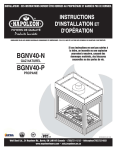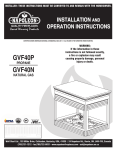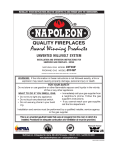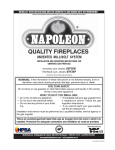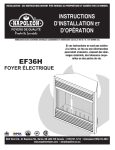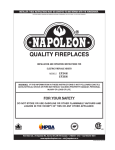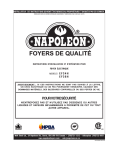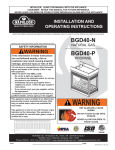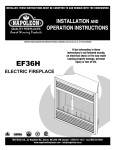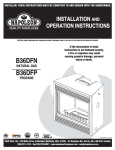Download Napoleon Fireplaces BGNV40-P User's Manual
Transcript
1 W415-0320 / D / 01.16.07 W415-0320 / D / 01.06.07 2 WARNINGS & SAFETY PRECAUTIONS WHAT TO DO IF YOU SMELL GAS W415-0320 / D / 01.06.07 3 TABLE of CONTENTS Pg 2-6 INTRODUCTION 13 Warnings and Safety Precautions Warranty General Instructions General Information Care of Glass & Plated Parts Dimensions 7 14-17 FINISHING Mantle Height Locations Heat shield stand-off removal Log Placement/Charcoal Embers Logo Placement Door Opening and Closing Upper Louvre Bracket and Hood Lower Louvre Bracket and Hinge Screen Louvre Installation End Door Installation VENTING Vent Safety Switch High Limit Switch Venting Action 8-9 PENINSULA INSTALLATION PROCEDURE Framing Bar / Countertop Installation Brick Panel Installation Facing 10 OPTIONAL BLOWER INSTALLATION 19 OPERATION / MAINTENANCE 20 OPEN END INSTALLATION PROCEDURE ADJUSTMENTS Pilot Burner Adjustment Venturi Adjustments 21-22 REPLACEMENTS Ordering Replacement Parts Replacement Parts SEE-THRU INSTALLATION PROCEDURE Framing Brick Panel Installation Facing 12 18 Operating Instructions Maintenance Framing Brick Panel Installation Facing 11 GAS SUPPLY CONNECTION 23 ISLAND INSTALLATION PROCEDURE Framing Brick Panel Installation Facing ACCESSORIES 24-25 TROUBLE SHOOTING GUIDE 26 SERVICE HISTORY PLEASE RETAIN THIS MANUAL FOR FUTURE REFERENCE WARNING • Do not burn wood or other materials in this fireplace. • Adults and especially children should be alerted to the hazards of high surface temperatures and should stay away to avoid burns or clothing ignition. Supervise young children when they are in the same room as the fireplace. • Due to high temperatures, the fireplace should be located out of traffic and away from furniture and draperies. • Clothing or other flammable material should not be placed on or near the fireplace. • Any safety screen or guard removed for servicing must be replaced prior to operating the fireplace. • It is imperative that the control compartments, burners and circulating blower and its passageway in the fireplace and venting system are kept clean. The fireplace and its venting system should be inspected before use and at least annually by a qualified service person. More frequent cleaning may be required due to excessive lint from carpeting, bedding material, etc. The fireplace area must be kept clear and free from combustible materials, gasoline and other flammable vapours and liquids. • Under no circumstances should this fireplace be modified. • This fireplace must not be connected to a chimney flue pipe serving a separate solid fuel burning appliance. • Do not use this fireplace if any part has been under water. Immediately call a qualified service technician to inspect the fireplace and to replace any part of the control system and any gas control which has been under water. • Do not operate the fireplace with the glass door removed, cracked or broken. Replacement of the glass should be done by a licensed or qualified service person. • Do not strike or slam shut the fireplace glass door. • This fireplace uses and requires a fast acting thermocouple. Replace only with a fast acting thermocouple supplied by Wolf Steel Ltd. NOTE: changes, other than editorial, are denoted by a vertical line in the margin. W415-0320 / D / 01.06.07 4 NAPOLEON gas fireplaces are manufactured under the strict Standard of the world recognized ISO 9001 : 2000 Quality Assurance Certificate. NAPOLEON products are designed with superior components and materials, assembled by trained craftsmen who take great pride in their work. The burner and valve assembly are leak and test-fired at a quality test station. The complete fireplace is thoroughly inspected by a qualified technician before packaging to ensure that you, the customer, receives the quality product that you expect from NAPOLEON. NAPOLEON GAS FIREPLACE PRESIDENT'S LIFETIME LIMITED WARRANTY The following materials and workmanship in your new NAPOLEON gas fireplace are warranted against defects for as long as you own the fireplace. This covers: combustion chamber, heat exchanger, stainless steel burner, phazer™ logs and embers, ceramic glass (thermal breakage only), gold plated parts against tarnishing, porcelainized enamelled components and aluminum extrusion trims. Electrical (110V and millivolt) components and wearable parts such as blowers, gas valves, thermal switch, switches, wiring, remote controls, ignitor, gasketing, and pilot assembly are covered and NAPOLEON will provide replacement parts free of charge during the first year of the limited warranty. Labour related to warranty repair is covered free of charge during the first year. Repair work, however, requires the prior approval of an authorized company official. Labour costs to the account of NAPOLEON are based on a predetermined rate schedule and any repair work must be done through an authorized NAPOLEON dealer. CONDITIONS AND LIMITATIONS NAPOLEON warrants its products against manufacturing defects to the original purchaser only -- i.e., the individual or legal entity (registered customer) whose name appears on the warranty registration card filed with NAPOLEON -- provided that the purchase was made through an authorized NAPOLEON dealer and is subject to the following conditions and limitations: This factory warranty is nontransferable and may not be extended whatsoever by any of our representatives. The gas fireplace must be installed by a licenced, authorized service technician or contractor. Installation must be done in accordance with the installation instructions included with the product and all local and national building and fire codes. This limited warranty does not cover damages caused by misuse, lack of maintenance, accident, alterations, abuse or neglect and parts installed from other manufacturers will nullify this warranty. This limited warranty further does not cover any scratches, dents, corrosion or discolouring caused by excessive heat, abrasive and chemical cleaners nor chipping on porcelain enamel parts, mechanical breakage of PHAZER™ logs and embers, nor any venting components used in the installation of the fireplace. NAPOLEON warrants its stainless steel burners against defects in workmanship and material for life, subject to the following conditions: During the first 10 years NAPOLEON will replace or repair the defective parts at our option free of charge. From 10 years to life, NAPOLEON will provide replacement burners at 50% of the current retail price. In the first year only, this warranty extends to the repair or replacement of warranted parts which are defective in material or workmanship provided that the product has been operated in accordance with the operation instructions and under normal conditions. After the first year, with respect to this President's Limited Lifetime Warranty, NAPOLEON may, at its discretion, fully discharge all obligations with respect to this warranty by refunding to the original warranted purchaser the wholesale price of any warranted but defective part(s). After the first year, NAPOLEON will not be responsible for installation, labour or any other costs or expenses related to the reinstallation of a warranted part, and such expenses are not covered by this warranty. Notwithstanding any provisions contained in this President's Limited Lifetime Warranty, NAPOLEON’S responsibility under this warranty is defined as above and it shall not in any event extend to any incidental, consequential or indirect damages. This warranty defines the obligations and liability of NAPOLEON with respect to the NAPOLEON gas fireplace and any other warranties expressed or implied with respect to this product, its components or accessories are excluded. NAPOLEON neither assumes, nor authorizes any third party to assume, on its behalf, any other liabilities with respect to the sale of this product. NAPOLEON will not be responsible for: over-firing, downdrafts, spillage caused by environmental conditions such as rooftops, buildings, nearby trees, hills, mountains, inadequate vents or ventilation, excessive venting configurations, insufficient makeup air, or negative air pressures which may or may not be caused by mechanical systems such as exhaust fans, furnaces, clothes dryers, etc. Any damages to fireplace, combustion chamber, heat exchanger, brass trim or other component due to water, weather damage, long periods of dampness, condensation, damaging chemicals or cleaners will not be the responsibility of NAPOLEON. The bill of sale or copy will be required together with a serial number and a model number when making any warranty claims from your authorized dealer. The warranty registration card must be returned within fourteen days to register the warranty. NAPOLEON reserves the right to have its representative inspect any product or part thereof prior to honouring any warranty claim. ALL SPECIFICATIONS AND DESIGNS ARE SUBJECT TO CHANGE WITHOUT PRIOR NOTICE DUE TO ON-GOING PRODUCT IMPROVEMENTS. NAPOLEON® IS A REGISTERED TRADEMARK OF WOLF STEEL LTD. PATENTS U.S. 5.303.693.801 - CAN. 2.073.411, 2.082.915. © WOLF STEEL LTD. W415-0320 / D / 01.06.07 5 INTRODUCTION GENERAL INSTRUCTIONS GENERAL INFORMATION THIS GAS FIREPLACE SHOULD BE INSTALLED AND SERVICED BY A QUALIFIED INSTALLER to conform with local codes. Installation practices vary from region to region and it is important to know the specifics that apply to your area, for example: in Massachusetts State: FOR YOUR SATISFACTION, ALL BURNER ASSEMBLIES HAVE BEEN TEST-FIRED TO ASSURE THEIR OPERATIONS AND QUALITY! Maximum input is 30,000 BTU/h for natural gas and propane. When the fireplace is installed at elevations above 4,500ft, and in the absence of specific recommendations from the local authority having jurisdiction, the certified high altitude input rating shall be reduced at the rate of 4% for each additional 1,000ft. Maximum output for natural gas is 20,400 BTU/hr at an efficiency of 68% with the fan on. Minimum inlet gas supply pressure is 4.5 inches water column for natural gas and 11 inches water column for propane. Maximum inlet gas pressure is 7 inches water column for natural gas and 13 inches water column for propane. Manifold pressure under flow conditions is 3.5 inches water column for natural gas and 10 inches water column for propane. This fireplace is approved for bedroom and bed-sitting room installations and is suitable for mobile home installation. • The fireplace damper must be removed or welded in the open position prior to installation of a fireplace insert or gas log. • The appliance off valve must be a “T” handle gas cock. • The flexible connector must not be longer than 36 inches. • The appliance is not approved for installation in a bedroom or bathroom unless the unit is a direct vent sealed combustion product. • WARNING: This product must be installed by a licensed plumber or gas fitter when installed within the commonwealth of Massachusetts. In absence of local codes, install to the current CAN/CGA B149 Installation Code in Canada or to the National Fuel Gas Code, ANSI Z223.1, and NFPA 54 in the United States. Mobile home installation must conform with local codes. In the absence of local codes, install to the current standard for gas equipped mobile housing CAN/CSA Z240 MH Series in Canada or the manufactured home construction and safety standard, Title 24 CFR, part 3280, or the Fire Safety Criteria for manufactured home installations, Sites and Community Standard ANSI/NFPA 5OIA in the United States. Purge all gas lines with the glass door of the fireplace open. Assure that a continuous gas flow is at the burner before closing the door. Under extreme vent configurations, allow several minutes (5-15) for the flame to stabilize after ignition. The fireplace and its individual shutoff valve must be disconnected from the gas supply piping system during any pressure testing of that system at test pressures in excess of 1/2 psig (3.5 kPa). The fireplace must be isolated from the gas supply piping system by closing its individual manual shutoff valve during any pressure testing of the gas supply piping system at test pressures equal to or less than 1/2 psig (3.5 kPa). When the fireplace is installed directly on carpeting, vinyl tile or other combustible material other than wood flooring, the fireplace shall be installed on a metal or wood panel extending the full width and depth. If the optional heat circulating blower is installed, the blower must be electrically connected and grounded in accordance with local codes. In the absence of local codes, use the current CSA C22.1 CANADIAN ELECTRICAL CODE in Canada or the ANSI/NFPA 70 NATIONAL ELECTRICAL CODE in the United States. Minimum clearance to combustible construction from the fireplace: sides, back, bottom, and top 0 inches recessed depth (corner installation) 25 inches Objects placed in front of the fireplace must be kept a minimum of 48" away from the glass front faces of the unit. NO EXTERNAL ELECTRICITY (110 VOLTS OR 24 VOLTS) IS REQUIRED FOR THE GAS SYSTEM OPERATION. Expansion / contraction noises during heating up and cooling down cycles are normal and are to be expected. If utilizing one of Wolf Steel's trim or surround kits, follow the framing instructions on page 14 and the finishing instructions on page 23, for removal of the top extension. CARE OF GLASS, AND PLATED PARTS Do not use abrasive cleaners to clean these parts. Buff lightly with a clean dry cloth. The glass is 3/16" tempered glass available from your Napoleon / Wolf Steel Ltd. dealer. Do not substitute materials. If the door glass should crack or break, do not operate the fireplace. Replace only with a door assembly certified with the fireplace. See DOOR, LOUVRE AND TRIM INSTALLATION for removal and replacement details. Clean the glass after the first 10 hours of operation with a recommended gas fireplace glass cleaner. Thereafter clean as required. Do not clean glass when hot! If the glass is not kept clean permanent discolouration and / or blemishes may result. Provide adequate ventilation air. Provide adequate accessibility clearance for servicing and operating the fireplace. Never obstruct the front opening of the fireplace. For safe and proper operation of the fireplace follow the venting instruction exactly. Provide a means for visually checking the vent connection to the fireplace after the fireplace is installed. In order to avoid the possibility of exposed insulation or vapour barrier coming in contact with the fireplace body, it is recommended that the walls of the fireplace enclosure be “finished” (ie: drywall/sheetrock), as you would finish any other outside wall of a home. This will ensure that clearance to combustibles is maintained within the cavity. W415-0320 / D / 01.06.07 6 DIMENSIONS ISLAND FIGURES 1a-d OPEN-END PENINSULA SEE-THRU W415-0320 / D / 01.06.07 7 VENTING This is a vented appliance and must be connected to a chimney in accordance with the current installation codes. In absence of local codes, install to the current National Fuel Gas Code, ANSI Z223.1, or the current CAN/CGA B149, Installation Codes. This model can be common-vented. A minimum five inch diameter (5"ø) B-vent or class A vent is required. A minimum 5' vent height is required. Secure the B-vent to the exhaust collar on the stove top with 3 screws. In cold climates, the use of a B-vent and an insulated chase is recommended. VENTING SAFETY SWITCH This thermally activated switch, located in front of the draft hood, senses an increase in temperature and acts as a safety shut-off (See 'A' below). It shuts down the gas to the main burner in the event of a severe downdraft of air or a blocked or disconnected chimney flue. If the flue is blocked or has no "draw", the safety switch will automatically shut off the supply of gas to the main burner within 10 minutes. HIGH LIMIT SWITCH This thermally activated switch, located in front of the draft hood, senses an increase in temperature and acts as a safety shut-off (See 'A' below). It shuts down the gas to the main burner in the unlikely event of the unit overheating. The HI Limit switch will automatically reset after the unit has cooled down, resuming gas flow to the main burner. VENT SAFETY SWITCH HIGH LIMIT SWITCH THERMOSTAT OR WALL SWITCH This switch must be manually reset by depressing the plunger. Refer to Figure 2. Tampering with the safety switch can result in carbon monoxide poisoning and possible death. The one wire running from the vent safety switch is attached to terminal 1 of the valve (See 'B' below). The other wire (laying loose in the valve control area) may be attached to a wall switch or thermostat. FIGURE 3 VALVE VENTING ACTION CHECK A test for correct venting action must be made before the installed unit can be left with the customer. Follow the procedure below: 1. Close all doors and windows in the room / start exhaust fans in the home / turn the fireplace blower off (if so equipped). 2. Set controls to "high" and light the unit. 3. Wait 5 minutes. Light a match and hold to the front of the draft hood. FIGURES 4 & 5. HI LIMIT SWITCH PLUNGER A FIGURE 4 Venting action is satisfactory, if smoke and flames are drawn into the draft hood. FIGURE 5 B Venting action is unsatisfactory, if the smoke spills back, and the flame splays outward. If venting action is unsatisfactory, turn off the unit, wait 10 minutes and try again. If the smoke is still not drawn into the draft hood, turn the unit off and check for vent blockage or restriction. If necessary, consult with a qualified inspector. The Vent Safety or Hi Limit switches must not be adjusted or disabled. FIGURE 2 In the event that either switch or any associated parts are exchanged, only original manufacturer's parts may be used. W415-0320 / D / 01.06.07 8 PENINSULA INSTALLATION PROCEDURE VENTING COUNTERTOP / BAR INSTALLATION Refer to page 7. FRAMING Note: In order to avoid the possibility of exposed insulation or vapour barrier coming in contact with the fireplace body, it is recommended that the walls of the fireplace enclosure be “finished” (ie: drywall/sheetrock), as you would finish any other outside wall of a home. This will ensure that clearance to combustibles is maintained within the cavity. It is best to frame your fireplace after it is positioned and the vent system is installed. Use 2x4's and frame to local building codes. FIGURE 6. When finishing the fireplace, combustible material may rest directly on of the top extension. Note: Maximum weight tolerance is 400 lbs, provided that it is evenly distributed across the top extensions of the fireplace. In order to achieve a countertop or bar type appearance with the minimum height allowed, framing must be noncombustible and may be done with metal studding attached to the top extension sides or the upper frame of the fireplace. FIGURE 9. FIGURE 6 A = 22 " minus finishing material thickness each side. To install the fireplace face flush with the finished wall, position the framework to accommodate the thickness of the finished wall. FIGURE 7 FIGURE 8 * The top extension may be removed if non-combustible framing is faced with a non-combustible material placed flush with the front face of the unit and extending from the top of the unit. (Example: cement board) (not supplied). Combustible counter / bar tops must maintain a minimum of 38½ inches from the base of the fireplace to the underside of the top. Figure 7. FIGURE 9 TOP EXTENTION TOP OF THE UNIT NOTE: Wolf Steel trim and/or surround kits will not totally cover the top extension of the fireplace. In order to obtain a smooth transition from the trim / surround to the wall, it is recommended that the top extension be removed and the unit be installed following the above procedure. W415-0320 / D / 01.06.07 9 BRICK PANEL INSTALLATION FACING Install the base panels as illustrated in steps 1-4 . The side panel sits under the bracket tab. Holding the side panel in position, bend down the tab to secure. DETAIL 5. Combustible materials may be installed flush with the front of the fireplace but must not cover any of the black faceareas of the fireplace. Non-combustible material (brick, stone or ceramic tile) may protrude in these areas. It is not necessary to install a hearth extension with this fireplace system. When roughing in the fireplace, raise the fireplace to accommodate for the thickness of the finished floor materials, i.e. tile, carpeting, hard wood, which if not planned for will interfere with the opening of the lower access door and the installation of many decorative flashing accessories. FIGURES 10a-e STEP 1 Objects placed in front of the fireplace should be kept a minimum of 48" away from the glass front faces. FIGURE 11 DRYWALL DRYWALL STEP 2 4" MIN STEP 3 FINISHING Refer to pages 14-17 for complete instructions regarding mantle requirements and installations, log placement, glass door and upper and lower louvre attachments. STEP 4 RETAINER STEP 5 DETAIL5 W415-0320 / D / 01.06.07 10 OPEN-END INSTALLATION PROCEDURE VENTING FIGURES 13a-c Refer to page 7. FRAMING Note: In order to avoid the possibility of exposed insulation or vapour barrier coming in contact with the fireplace body, it is recommended that the walls of the fireplace enclosure be “finished” (ie: drywall/sheetrock), as you would finish any other outside wall of a home. This will ensure that clearance to combustibles is maintained within the cavity. It is best to frame your fireplace after it is positioned and the vent system is installed. Use 2x4's and frame to local building codes. FIGURE 12. STEP 5 RETAINER FIGURE 12 DETAIL 6 STEP 6 FACING Combustible materials may be installed flush with the front of the fireplace but must not cover any of the black faceareas of the fireplace. Non-combustible material (brick, stone or ceramic tile) may protrude in these areas. It is not necessary to install a hearth extension with this fireplace system. When roughing in the fireplace, raise the fireplace to accommodate for the thickness of the finished floor materials, i.e. tile, carpeting, hard wood, which if not planned for will interfere with the opening of the lower access door and the installation of many decorative flashing accessories. A = 251/4" minus finishing material thickness each side. NOTE: LEFT CORNER UNIT ILLUSTRATED To install the fireplace face flush with the finished wall, position the framework to accommodate the thickness of the finished wall. BRICK PANEL INSTALLATION Install the base panels as illustrated in steps 1-4 on page 9. The side panel sits under the bracket tab. Holding the side panel in position, bend down the tab to secure. DETAIL 6. Objects placed in front of the fireplace should be kept a minimum of 48" away from the glass front faces. FINISHING Refer to pages 14-17 for complete instructions regarding mantle requirements and installations, log placement, glass door and upper and lower louvre attachments. FIGURE 14 DRYWALL DRYWALL 4" MIN W415-0320 / D / 01.06.07 11 SEE-THROUGH INSTALLATION PROCEDURE VENTING FACING Refer to page 7. FRAMING Note: In order to avoid the possibility of exposed insulation or vapour barrier coming in contact with the fireplace body, it is recommended that the walls of the fireplace enclosure be “finished” (ie: drywall/sheetrock), as you would finish any other outside wall of a home. This will ensure that clearance to combustibles is maintained within the cavity. It is best to frame your fireplace after it is positioned and the vent system is installed. Use 2x4's and frame to local building codes. FIGURE 15. See PAGE 7 for bar type / countertop installation. FIGURE 15 Combustible materials may be installed flush with the front of the fireplace but must not cover any of the black faceareas of the fireplace. Non-combustible material (brick, stone or ceramic tile) may protrude in these areas. It is not necessary to install a hearth extension with this fireplace system. When roughing in the fireplace, raise the fireplace to accommodate for the thickness of the finished floor materials, i.e. tile, carpeting, hard wood, which if not planned for will interfere with the opening of the lower access door and the installation of many decorative flashing accessories. Objects placed in front of the fireplace should be kept a minimum of 48" away from the glass front faces. FINISHING Refer to pages 14-17 for complete instructions regarding mantle requirements and installations, log placement, glass door and upper and lower louvre attachments. FIGURE 17 DRYWALL DRYWALL A = 221/8" minus finishing material thickness, each side. BRICK PANEL INSTALLATION Install the base panels as illustrated in steps 1-4 on page 9. Both side panels sit under the bracket tab. Holding the side panel in position, bend down the tab to secure. DETAIL 6. FIGURES 16a-c 4" MIN RETAINER STEP 5 DETAIL 5 & 6 RETAINER STEP 6 W415-0320 / D / 01.06.07 12 ISLAND INSTALLATION PROCEDURE FRAMING BRICK PANEL INSTALLATION It is best to frame your fireplace after it is positioned. Use 2x4's and frame to local building codes. FIGURE 18. Install the base panels as illustrated in steps 1-4 on page 9. FACING FIGURE 18 Combustible materials may be installed flush with the front of the fireplace but must not cover any of the black faceareas of the fireplace. Non-combustible material (brick, stone or ceramic tile) may protrude in these areas. It is not necessary to install a hearth extension with this fireplace system. When roughing in the fireplace, raise the fireplace to accommodate for the thickness of the finished floor materials, i.e. tile, carpeting, hard wood, which if not planned for will interfere with the opening of the lower access door and the installation of many decorative flashing accessories. Objects placed in front of the fireplace should be kept a minimum of 48" away from the glass front faces. A = 221/8 " minus finishing material thickness each side. B = 36 " minus finishing material thickness each end. FIGURE 20 To install the fireplace face flush with the finished wall, position the framework to accommodate the thickness of the finished wall. FIGURE 19 DRYWALL DRYWALL FINISHING Refer to pages 14-17 for complete instructions regarding mantle requirements and installations, log placement, glass door and upper and lower louvre attachments. W415-0320 / D / 01.06.07 13 GAS INSTALLATION 1 2 O LO ON PL T IH O I 3 PI L OT Do not connect either the wall switch, thermostat or gas valve to electricity (110 volts). FIGURE 21 FF Proceed once the vent installation is complete. 1. Move the fireplace into position and secure using the nailing tabs and/or secure to the floor through the 1/4"ø holes located at either end of the base. 2. Route a 3/8" N.P.T. black iron gas line, 1/2" type-L copper tubing or equivalent to the fireplace. 3. For ease of accessibility, an optional remote wall switch or millivolt thermostat may be installed in a convenient location. Route 2-strand (solid core) millivolt wire through the electrical hole located at the bottom left side of the unit. The recommended maximum lead length depends on wire size: WIRE SIZE MAX. LENGTH 14gauge 100 feet 16gauge 60 feet 18gauge 40 feet Attach the one lead to terminal 3 (located on the gas valve) and the other lead to the vent safety switch wire ( located loose in the valve compartment). See FIGURE 3. 4. Install rigid black pipe, 1/2" type-L copper tubing or, if local codes permit, a 3/8" flex connector and shutoff valve to the gas line and the fireplace gas valve. Seal and tighten securely. An adapter fitting is required between the gas valve and the copper tubing or flex connector. DO NOT KINK FLEXIBLE CONNECTOR. FIGURE 6. 5. Check for gas leaks by brushing on a soap and water solution. Do not use open flame. FIGURE 22 6. Mark the appropriate boxes on the rating plate label to indicate the model type. Purge all gas lines with the glass door of the fireplace open. Assure that a continuous gas flow is at the burner before closing the door. FIGURE 23 W415-0320 / D / 01.06.07 14 FINISHING MANTLE INSTALLATION Combustible mantle clearance can vary according to the mantle depth. Use the graph to help evaluate the clearance needed. The three-sided top extension piece may be removed if non-combustible framing is faced with a non-combustible material. HEAT SHIELD STAND-OFF REMOVAL FIGURE 26 HE AT S HIE FIGURE 24 Dashed lines are suitable mantle sizes and clearances when a non-combustible facing is used. STA ND LD -OF FS END HEAT SHIELD SHOWN FIGURE 25 When using a non-combustible finishing material, the standoffs may be removed, by removing the set screw in the centre and sliding the stand-offs out of the mounting clips. * SEE FIGURE 9. W415-0320 / D / 01.06.07 15 LOG PLACEMENT E TM PHAZER logs, glowing and charcoal embers, exclusive to Napoleon fireplaces, provide a unique and realistic glowing effect that is different in every installation. Take the time to carefully position the embers for a maximum glowing effect. Figures 27 A - H. A #1 LOCATING PINS #3 LOCATING PINS PILOT 5. When pieces #3a and #3b are attached to create log #3, the upper end of log #3 should rest in the groove, on top of log # 2. F 1. Looking at the unit from the valve side, place log #1 diagonally across the textured burner cover onto the pins. The texture is designed to cradle the underside of the log. B #4 #2 6. As with log # 1, log #4 is also cradled by the texture of the burner cover and the pin in the base. Position log #4 so that the lower end fits onto the pin. The upper end rests against the moulded locater on the top of log # 1. G #5 b 2. Depending on the type of installation, the view of the log positioning will reverse. Here the lower end of log #2 rests near the back left corner of the firebox on the locating pin. The upper end sits on top of log #1, inside the groove on log #2. C 7. Like log #3, log #5 also comes in two pieces. The base (#5a) slopes outwards between logs #2 and #4. As with pieces #3a & b, piece #5b fits over piece #5a. Place the end of piece #5b onto the pin. a #3a H #2 #5 #3 D #3 b a 3. Log # 3 is made up of two pieces, a and b. Piece #3a is the base of log #3. The base sits diagonally in the designated area located between logs #1 and fits tight up against #2. #1 #4 8. The upper end of log #5 rests in the groove, on top of log #4 and creates the final appearance of log set. 4. The slot in the underside of piece #3b fits over #3a. Place the end of piece #3b onto the pin. W415-0320 / D / 01.06.07 16 GLOWING EMBERS L36 LOUVRE INSTALLATION For proper ignition, it is very important to that glowing ember s ar e in place embers are place.. Tear the embers into small pieces and place on the ported area of the burner. Care should be taken to shred the embers into thin, small irregular pieces as only the exposed edges of the fibre hairs will glow. The ember material will only glow when exposed to direct flame; however, care should be taken to not block the burner ports. Blocked burner ports can cause an incorrect flame pattern, carbon deposits and delayed ignition. PHAZERTM logs glow when exposed to direct flame. FIGURE 36 a-c A B CHARCOAL EMBERS Randomly place the embers around the bottom brick panels in a realistic manner but not in contact with the flames. Keep ember dust away from burner ports to avoid plugging them. C Fine dust found in bottom of bag not to be used. PHAZERTM logs, and embers glow when exposed to direct flame. Use only certified PHAZERTM logs, glowing embers and charcoal embers available from your Napoleon / Wolf Steel Ltd. dealer. FIGURE 28 A CLIPS GLOWING EMBERS FLANGE CENTRE HOOD Attach the hood by pressing the top flange into the clips along the top of the louvre opening. Secure using a screw through the centre slot. SLOT Ensure that glowing embers sufficiently cover the carry over ports, highlighted below, to achieve maximum glow. SLOT CARRY OVER PORTS UPPER LOUVRES Insert the louvre tabs into the slots located at the top left and right corners of the unit. TA B B C HINGE CLIP FIGURE 29 LOGO PLACEMENT Remove the backing of the logo supplied and place on the glass viewing door, as indicated. ½" LOGO ½" FIGURE 30 W415-0320 / D / 01.06.07 SLOT LOWER LOUVRES Insert the hinge clips into the slots located at the bottom left and right corners of the unit. To remove the louvres, pull the back tabs of the clips forward, while pushing the louvre assembly back. Lift the clip. 17 END DOOR INSTALLATION Ensure that the door is properly clipped onto the steel lip to prevent overheating, glass breakage and / or discolouration of the upper trim. FIGURE 38 FIGURE 37 STEEL LIP DOOR To install the door(s), hook it over the steel lip located above the door opening. Secure with screws along the bottom of the door. Tighten screws snugly. Do not overtighten. FIGURE 39 W415-0320 / D / 01.06.07 18 OPTIONAL BLOWER INSTALLATION THIS BLOWER IS NOT SUITABLE FOR THE 4 SIDED ISLAND INSTALLATION. THERMODISC WIRES TO BLOWER in accordance with local codes. In the absence of local codes, use the current CSA C22.1 CANADIAN ELECTRICAL CODE in Canada or the ANSI/NFPA 70 NATIONAL ELECTRICAL CODE in the United States. Remove the blower from its mounting bracket and attach to the bracket supplied with the fireplace. FIGURE 40 This bracket is found secured on the mounting stud located at the bottom of the vent side wall. FIGURE 41 FIGURE 42 The blower bracket contains two holes that allow the blower to be positioned away from the intended gas supply hole. Position the vibration reducing pad, centred, onto the threaded stud, piercing a hole into the pad. The blower must be able to be positioned entirely onto the pad. Tilt the blower onto its side and slide it past the controls. Position the blower under the clip and onto the stud. Secure with a wing nut. FIGURE 43 W415-0320 / D / 01.06.07 THERMODISC BRACKET FIGURE 44 Remove the thermodisc bracket from the top of the firebox. Remove the thermodisc from the bracket supplied in the blower kit and install the thermodisc into the fireplace bracket. Then replace the bracket in the location it was removed. Connect the two ends of the unattached wires by the bracket to the thermodisc. Connect the opposite ends of the wires to the red and black leads of the blower harness. The wire harness provided in this kit is a universal harness. When installed, ensure that any excess wire is contained, preventing it from making contact with moving or hot objects. Drywall dust will penetrate into the blower bearings, causing irreparable damage. Care must be taken to prevent drywall dust from coming into contact with the blower or its compartment. Any damage resulting from this condition is not covered by the warranty policy. Because the blower is thermally activated, when turned on, it will automatically start approximately 10 minutes after lighting the fireplace and will run for approximately 30 - 45 minutes after the fireplace has been turned off. Use of the fan increases the output of heat. 19 OPERATION / MAINTENANCE FOR YOUR SAFETY READ BEFORE LIGHTING: WHAT TO DO IF YOU SMELL GAS: Purge the gas line with a glass door open. Assure that a continuous gas flow is at the burner before re-installing the door. A. This fireplace is equipped with a pilot which must be lit by hand while following these instructions exactly. B. Before operating smell all around the fireplace area for gas and next to the floor because some gas is heavier than air and will settle on the floor. C. Use only your hand to turn the gas control knob. Never use tools. If the knob will not turn by hand, do not try to repair it. Call a qualified service technician. Force or attempted repair may result in a fire or explosion. D. Do not use this fireplace if any part has been under water. Immediately call a qualified service technician to inspect the fireplace and replace any part of the control system and any gas control which has been under water. • Turn off all gas to the fireplace. • Open windows. • Do not try to light any appliance. • Do not touch any electric switch; do not use any phone in your building. • Immediately call your gas supplier from a neighbour's phone. Follow the gas supplier's instructions. • If you cannot reach your gas supplier, call the fire department. WARNING: The gas valve has an interlock GAS KNOB device which will not allow the pilot burner to be lit until the thermocouple has cooled. Allow approximately 60 seconds for the thermocouple to cool. When lighting and re-lighting, the gas knob cannot be turned from pilot to off unless the knob is depressed slightly. LIGHTING INSTRUCTIONS 1. 2. 3. 4. Stop! Read the above safety information on this label. Turn off all electric power to the fireplace. Turn the gas knob clockwise to off. Wait five (5) minutes to clear out any gas. If you smell gas including near the floor. Stop! Follow "B" in the above safety information on this label. If you don't smell gas go the next step. 5. Turn gas knob counter-clockwise to pilot. 6. Depress slightly and hold gas knob while lighting the pilot with the push button ignitor. Keep knob depressed for one minute, then release. If pilot does not continue to burn, repeat steps 3 through 5. 7. With pilot lit, depress and turn gas knob counter-clockwise to on. 8. If equipped with remote on-off switch/thermostat, main burner may not come on when you turn valve to on. Remote switch must be in the on position to ignite burner. 9. Turn on all electric power to the fireplace. TO TURN OFF GAS 1. Turn off all electric power to the fireplace if service is to be performed. 2. For a complete shut-down procedure: push in gas control knob slightly and turn clockwise to off. Do not force. 3. For a temporary shut-down procedure: set thermostat to lowest setting or remote switch to off. Press and turn the gas knob clockwise to pilot. Turn off the gas and electrical power before servicing the fireplace. MAINTENANCE CAUTION: Label all wires prior to disconnection when servicing controls. Wiring errors can cause improper and dangerous operation. Verify proper operation after servicing. This fireplace and its venting system should be inspected before use and at least annually by a qualified service person. The fireplace area must be kept clear and free of combustible materials, gasoline or other flammable vapours and liquids. The flow of combustion and ventilation air must not be obstructed. 1. In order to properly clean the burner and pilot assembly, remove the logs to expose both assemblies. 2. Keep the control compartment, logs, burner, air shutter opening and the area surrounding the logs clean by vacuuming or brushing, at least once a year. 3. Check to see that all burner ports are burning. Clean out any of the ports which may not be burning or are not burning properly. 4. Check to see that the pilot flame is large enough to engulf the thermocouple and thermopile and reaches toward the burner with the third jet. 5. Replace the cleaned logs. 6. Check to see that the main and runner burners ignite completely on all openings when the gas knob for the burners is turned on. A 5 to 10 second total light-up period is satisfactory. If ignition takes longer, consult your Napoleon dealer / distributor. 7. Check that the gasketing on the sides, top and bottom of the door is not broken or missing. Replace if necessary. W415-0320 / D / 01.06.07 20 ADJUSTMENTS PILOT BURNER ADJUSTMENT AIR SHUTTER ADJUSTMENT MUST ONLY BE DONE BY A QUALIFIED GAS INSTALLER! Adjust the pilot screw to provide properly sized flame. Turn in a clockwise direction to reduce the gas flow. FIGURE 47 FIGURE 45 VENTURI FIGURE 46 VENTURI ADJUSTMENT MODEL BGNV40 NG 1/4" LP 7/16" Closing the air shutter will cause a more yellow flame, but can lead to carboning. Opening the air shutter will cause a more blue flame, but can cause flame lifting from the burner ports. The flame may not appear yellow immediately; allow 15 to 30 minutes for the final flame colour to be established. W415-0320 / D / 01.06.07 FIGURE 48 21 REPLACEMENTS Contact your dealer for questions concerning prices and availability of replacement parts. Normally all parts can be ordered through your Napoleon dealer or distributor. * IDENTIFIES ITEMS WHICH ARE NOT ILLUSTRATED. FOR FURTHER INFORMATION, CONTACT YOUR NAPOLEON DEALER. When ordering replacement parts always give the following information: 1. MODEL & SERIAL NUMBER OF FIREPLACE 2. INSTALLATION DATE OF FIREPLACE 3. PART NUMBER 4. DESCRIPTION OF PART 5. FINISH 6. TOP OR REAR VENT COMPONENTS COMMON TO ALL UNITS # PART No. DESCRIPTION 1* 2* 3 4 5 6* 7 8 9 10 11 12 13 14 15 16 17 18 19 20 W361-0016 W550-0001 W010-0516 W562-0009 W010-0454 W385-0245 GL-634 W135-0153 W135-0154 W135-0155 W135-0156 W135-0157 W135-0158 W135-0159 W475-0511 W475-0512 W475-0515 W475-0513 W080-0519 W565-0041 GLOWING EMBERS CHARCOAL EMBERS BLACK SIDE DOOR c/w GLASS DOOR GASKET (100 INCHES) GLASS W/ GASKET NAPOLEON LOGO BGNV40 LOGSET LOG#1 LOG#2 LOG#3 - PIECE A LOG#3 - PIECE B LOG#4 LOG#5 - PIECE A LOG#5 - PIECE B END FIBRE BRICK PANEL - FOR BURNER END FIBRE BRICK PANEL - FOR BURNER SIDE FIBRE BRICK PANEL - FOR BURNER SIDE FIBRE BRICK PANEL - FOR BURNER BOTTOM LOUVRE BRACKET SIDE HINGE SCREEN BURNER COMPONENTS 32 33 W010-0871 W010-0801 REPLACEMENT BURNER NATURAL GAS PILOT ASSEMBLY 33 W010-0800 PROPANE GAS PILOT ASSEMBLY 34 34 W455-0069 W455-0067 NATURAL GAS PILOT INJECTOR PROPANE GAS PILOT INJECTOR 35* 36 37 38 39 40 W660-0005 W680-0004 W680-0005 W240-0006 W357-0001 N455-0003 BURNER ON/OFF SWITCH THERMOPILE THERMOCOUPLE ELECTRODE W / WIRE PIEZO IGNITER MAIN BURNER ORIFICE - PROPANE COMPONENTS UNIQUE TO OPEN END UNIT 21 22 23 24 25 26 27 28 29 30 31 W475-0516 W500-0193 W200-0114 N010-0327 W300-0057 W475-0517 W010-0873 W500-0192 W565-0054 W585-0126 N010-0323 END FIBRE BRICK PANEL - FOR WALL BRICK PANEL RETAINER SIDE DOOR COVER SIDE DOOR HEAT SHIELD END DOOR TEMPERED GLASS ONLY SIDE BRICK PANEL - FOR WALL BLACK END DOOR c/w GLASS END BRICK PANEL RETAINER END HINGE SCREEN END DOOR HEAT SHIELD END DOOR COVER COMPONENTS UNIQUE TO SEE-THRU UNIT 21 28 30 31 21 27 28 29 30 31 27 29 W475-0516 W500-0192 W585-0126 N010-0323 END END END END FIBRE BRICK PANEL - FOR BRICK PANEL RETAINER DOOR HEAT SHIELD DOOR COVER WALL W475-0516 W010-0873 W500-0192 W565-0054 W585-0126 N010-0323 END FIBRE BRICK PANEL - FOR BLACK END DOOR c/w GLASS END BRICK PANEL RETAINER END HINGE SCREEN END DOOR HEAT SHIELD END DOOR COVER WALL W010-0873 W565-0054 BLACK END DOOR c/w GLASS END HINGE SCREEN COMPONENTS UNIQUE TO PENINSULA UNIT COMPONENTS UNIQUE TO ISLAND UNIT W415-0320 / D / 01.06.07 22 W415-0320 / D / 01.06.07 * WARNING: This is a fast acting thermocouple. It is an integral safety component. Replace only with a fast acting thermocouple supplied by Wolf Steel Ltd. 23 ACCESSORIES # PART No. 1* 2* 3 4 5 5 5 5 6 6 6 6 7 7 7 7 8 8 8 8 9 9 9 9 10 10 10 10 W690-0001 GZ-550-1KT L36K ELB40K HOIG-1 HOIKG-1 HOIBC-1 HOIBG -1 EHOIG-1 EHOIKG-1 EHOIBC-1 EHOIBG-1 DOIG-1 DOIKG-1 DOIBC-1 DOIBG-1 EDOIG-1 EDOIKG-1 EDOIBC-1 EDOIBG-1 GOIG-1 GOIKG-1 GOIBC-1 GOIBG-1 EGOIG-1 EGOIKG-1 EGOIBC-1 EGOIBG-1 DESCRIPTION MILLIVOLT THERMOSTAT BLOWER KIT LOUVRE KIT-UPPER & LOWER -BLACK END LOUVRE KIT-BLACK HERITAGE ORNAMENTAL INSET-GOLD PLATED HERITAGE ORNAMENTAL INSET-BLACK GOLD PLATED HERITAGE ORNAMENTAL INSET-BRUSHED COPPER PLATED HERITAGE ORNAMENTAL INSET-BRUSHED GOLD PLATED END HERITAGE ORNAMENTAL INSET-GOLD PLATED END HERITAGE ORNAMENTAL INSET-BLACK GOLD PLATED END HERITAGE ORNAMENTAL INSET-BRUSHED COPPER PLATED END HERITAGE ORNAMENTAL INSET-BRUSHED GOLD PLATED DIAMOND ORNAMENTAL INSET-GOLD PLATED DIAMOND ORNAMENTAL INSET-BLACK GOLD PLATED DIAMOND ORNAMENTAL INSET-BRUSHED COPPER PLATED DIAMOND ORNAMENTAL INSET-BRUSHED GOLD PLATED END DIAMOND ORNAMENTAL INSET-GOLD PLATED END DIAMOND ORNAMENTAL INSET-BLACK GOLD PLATED END DIAMOND ORNAMENTAL INSET-BRUSHED COPPER PLATED END DIAMOND ORNAMENTAL INSET-BRUSHED GOLD PLATED GOTHIC ORNAMENTAL INSET- GOLD PLATED GOTHIC ORNAMENTAL INSET-BLACK GOLD PLATED GOTHIC ORNAMENTAL INSET- BRUSHED COPPER PLATED GOTHIC ORNAMENTAL INSET-BRUSHED GOLD PLATED END GOTHIC ORNAMENTAL INSET-GOLD PLATED END GOTHIC ORNAMENTAL INSET-BLACK GOLD PLATED END GOTHIC ORNAMENTAL INSET-BRUSHED COPPER PLATED END GOTHIC ORNAMENTAL INSET-BRUSHED GOLD PLATED 11 11 11 11 12 12 12 12 13 13 13 13 14 14 14 14 15* 15* 16* 17* SOIG-1 SOIKG-1 SOIBC-1 SOIBG-1 ESOIG-1 ESOIKG-1 ESOIBC-1 ESOIBG-1 EOIG-1 EOIKG-1 EOIBC-1 EOIBG-1 EEOIG-1 EEOIKG-1 EEOIBC-1 EEOIBG-1 GD825N GD825P W175-0205 FC-12 SEASHELL ORNAMENTAL INSET-GOLD PLATED SEASHELL ORNAMENTAL INSET-BLACK GOLD PLATED SEASHEL ORNAMENTAL INSET- BRUSHED COPPER PLATED SEASHELL ORNAMENTAL INSET-BRUSHED GOLD PLATED END SEASHELL ORNAMENTAL INSET-GOLD PLATED END SEASHELL ORNAMENTAL INSET-BLACK GOLD PLATED END SEASHELL ORNAMENTAL INSET- BRUSHED COPPER PLATED END SEASHELL ORNAMENTAL INSET-BRUSHED GOLD PLATED ECLIPSE ORNAMENTAL INSET-GOLD PLATED ECLIPSE ORNAMENTAL INSET-BLACK GOLD PLATED ECLIPSE ORNAMENTAL INSET- BRUSHED COPPER PLATED ECLIPSE ORNAMENTAL INSET-BRUSHED GOLD PLATED END ECLIPSE ORNAMENTAL INSET-GOLD PLATED END ECLIPSE ORNAMENTAL INSET-BLACK GOLD PLATED END ECLIPSE ORNAMENTAL INSET-BRUSHED COPPER PLATED END ECLIPSE ORNAMENTAL INSET-BRUSHED GOLD PLATED VALVE REGULATOR FOR W660-0013-NATURAL GAS VALVE REGULATOR FOR W660-0013-PROPANE CONVERSION KIT-NG-LP GAS FLEX CONNECTOR & SHUT OFF - 12" STAINLESS STEEL W415-0320 / D / 01.06.07 24 TROUBLE SHOOTING GUIDE BEFORE ATTEMPTING TO TROUBLESHOOT, PURGE YOUR UNIT AND INITIALLY LIGHT THE PILOT AND THE MAIN BURNER WITH THE GLASS DOOR OPEN. SYMPTOM PROBLEM TEST SOLUTION Main burner goes Pilot flame is not large - turn up pilot flame. out; pilot stays on. enough or not engulfing the - replace pilot assembly. thermopile Thermopile shorting - clean thermopile connection to the valve. Reconnect. - replace thermopile / valve. Remote wall switch wire is - shorten wire to correct length or wire gauge. too long; too much resistance in the system. Faulty thermostat or switch. - replace. Vent safety switch has opened. (Tripped) Hi Limit switch has opened. (Tripped) - Vent has become blocked or disconnected. Correct. See Figure 2. - Unit has overheated. See Figure 2 Main burner goes Refer to "MAIN BURNER GOES OUT; PILOT STAYS ON" out; pilot goes out. Faulty thermocouple. - replace. Pilot goes out when the gas knob is released. The gas valve has an interlock device which will not allow the pilot burner to be lit until the thermocouple has cooled. Allow approximately 60 seconds for the thermocouple to cool. System is not correctly - purge the gas line with the glass door open. purged. Pilot burning; no gas to main burner; gas knob is on 'HI'; wall switch / thermostat is on. Out of propane gas. - fill the tank. Pilot flame is not large - turn up the pilot flame. enough Pilot flame is not engulfing the thermocouple. Thermocouple shorting / faulty. - gently twist the pilot head to improve the flame pattern around the thermocouple. - loosen and tighten thermocouple. - clean thermocouple and valve connection. - replace thermocouple. Faulty valve. - replace. Themostat or switch is defective. Wall switch wiring is defective. - connect a jumper wire across the wall switch terminals; if main burner lights, replace switch / thermostat. - disconnect switch wires & connect a jumper wire across terminals 1 & 3; if the main burner lights, check the wires for defects and / or replace wires. - remove stoppage in orifice. Main burner orifice is plugged. - replace. Faulty valve. Vent safety switch has opened. - Vent has become blocked or disconnected. Correct. See Figure 2. (Tripped) Hi Limit switch has opened. (Tripped) - Unit has overheated. See Figure 2 Pilot will not light. No spark at pilot burner Out of propane gas Spark gap is incorrect No gas at the pilot burner W415-0320 / D / 01.06.07 - check if pilot can be lit by a match - check that the wire is connected to the push button ignitor. - check if the push button ignitor needs tightening. - replace the wire if the wire insulation is broken or frayed. - replace the electrode if the ceramic insulator is cracked or broken. - replace the push button ignitor. - fill the tank. - spark gap should be 0.150" to 0.175" (5/32" to 11/64" approx.) from the electrode tip and the pilot burner. To ensure proper electrode location, tighten securing nut (finger tight plus 1/4 turn). - check that the manual valve is turned on. - check the pilot orifice for blockage. - replace the valve. - call the gas distributor. 25 SYMPTOM PROBLEM Pilot goes out Gas piping is undersized. while standing; Main burner is in 'OFF' position. TEST SOLUTION - turn on all gas appliances and see if pilot flame flutters, diminishes or extinguishes, especially when main burner ignites. Monitor appliance supply working pressure. - check if supply piping size is to code. Correct all undersized piping. Flames are con- Unit is over-fired or under- - check pressure readings: sistently too large fired. Inlet pressure can be checked by turning screw (A) counter-clockor too small. wise 2 or 3 turns and then placing pressure gauge tubing over the Carboning occurs. test point. Gauge should read 7" (minimum 4.5") water column for natural gas or 13" (11" minimum) water column for propane. Check that main burner is operating on "HI". Outlet pressure can be checked the same as above using screw (B). Gauge should read 3.5" water column for natural gas or 10" water column for propane. Check that main burner is operating on "HI". AFTER TAKING PRESSURE READINGS, BE SURE TO TURN SCREWS CLOCKWISE FIRMLY TO RESEAL. DO NOT OVERTORQUE. Leak test with a soap and water solution. Carbon is being deposited on glass, logs or combustion chamber surfaces. Air shutter has become blocked - ensure air shutter opening is free of lint or other obstructions. Flame is impinging on the logs or combustion chamber. - check that the logs are correctly positioned. - open air shutter to increase the primary air. - check the input rate: check the manifold pressure and orifice size as specified by the rating plate values. - check to ensure proper venting action White / grey film Sulphur from fuel is being forms. deposited on glass, logs or combustion chamber surfaces. - clean the glass with a recommended gas fireplace glass cleaner. DO NOT CLEAN GLASS WHEN HOT. If deposits are not cleaned off regularly, the glass may become permanently marked. Exhaust fumes Fireplace is spilling. smelled in room, headaches. - check for chimney blockage - check that chimney is installed to building code. - room is in negative pressure; increase fresh air supply. Main burner flame Not enough combustion air is a blue, lazy, transparent flame. - room is in negative pressure; increase fresh air supply Remote wall switch is in "OFF" position; main burner comes on when gas knob is turned to "ON" position. Wall switch is mounted up- - reverse. side down Remote wall switch is - replace. grounding. Remote wall switch wire is - check for ground (short); repair ground or replace wire. grounding. - replace. Faulty valve. W415-0320 / D / 01.06.07 Date Dealer Name Service Technician Name Service Performed This fireplace must be serviced annually depending on usage. Wolf Steel Fireplace Service History Special Concerns 26 W415-0320 / D / 01.06.07 NOTES 28 NOTES W415-0320 / D / 01.06.07




























